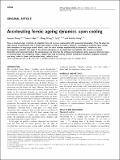| dc.contributor.author | Zhang, Junyan | |
| dc.contributor.author | Mao, Yunwei | |
| dc.contributor.author | Wang, Dong | |
| dc.contributor.author | Li, Ju | |
| dc.contributor.author | Wang, Yunzhi | |
| dc.date.accessioned | 2018-07-24T15:33:40Z | |
| dc.date.available | 2018-07-24T15:33:40Z | |
| dc.date.issued | 2016-10 | |
| dc.date.submitted | 2016-05 | |
| dc.identifier.issn | 1884-4049 | |
| dc.identifier.issn | 1884-4057 | |
| dc.identifier.uri | http://hdl.handle.net/1721.1/117074 | |
| dc.description.abstract | Once a structural glass is formed, its relaxation time will increase exponentially with decreasing temperature. Thus, the glass has little chance of transforming into a crystal upon further cooling to zero Kelvin. However, a spontaneous transition upon cooling from amorphous to long-range ordered ferroic states has been observed experimentally in ferroelastic, ferroelectric and ferromagnetic materials. The origin for this obvious discrepancy is discussed here conceptually. We present a combined theoretical and numerical study of this phenomenon and show that the diffusive and displacive atomic processes that take place in structural glass and amorphous ferroics, respectively, lead to markedly different temperature-dependent relaxation behaviors, one being ‘colder is slower’ and the other being ‘colder is faster’. | en_US |
| dc.description.sponsorship | National Basic Research Program of China (2012CB619402) | en_US |
| dc.description.sponsorship | National Basic Research Program of China (2014CB644003) | en_US |
| dc.description.sponsorship | National Key Basic Research Program of China (51671156) | en_US |
| dc.description.sponsorship | National Basic Research Program of China 111 Project (B06025) | en_US |
| dc.description.sponsorship | National Science Foundation (U.S.). Division of Materials Research (DMR-1410322) | en_US |
| dc.description.sponsorship | National Science Foundation (U.S.). Division of Materials Research (DMR-1410636) | en_US |
| dc.publisher | Springer Nature | en_US |
| dc.relation.isversionof | http://dx.doi.org/10.1038/AM.2016.152 | en_US |
| dc.rights | Creative Commons Attribution 4.0 International License | en_US |
| dc.rights.uri | http://creativecommons.org/licenses/by/4.0/ | en_US |
| dc.source | Nature | en_US |
| dc.title | Accelerating ferroic ageing dynamics upon cooling | en_US |
| dc.type | Article | en_US |
| dc.identifier.citation | Zhang, Junyan, Yunwei Mao, Dong Wang, Ju Li, and Yunzhi Wang. “Accelerating Ferroic Ageing Dynamics Upon Cooling.” NPG Asia Materials 8, no. 10 (October 2016): e319–e319. | en_US |
| dc.contributor.department | Massachusetts Institute of Technology. Department of Mechanical Engineering | en_US |
| dc.contributor.department | Massachusetts Institute of Technology. Department of Nuclear Science and Engineering | en_US |
| dc.contributor.mitauthor | Mao, Yunwei | |
| dc.contributor.mitauthor | Wang, Dong | |
| dc.contributor.mitauthor | Li, Ju | |
| dc.contributor.mitauthor | Wang, Yunzhi | |
| dc.relation.journal | NPG Asia Materials | en_US |
| dc.eprint.version | Final published version | en_US |
| dc.type.uri | http://purl.org/eprint/type/JournalArticle | en_US |
| eprint.status | http://purl.org/eprint/status/PeerReviewed | en_US |
| dc.date.updated | 2018-07-23T16:12:07Z | |
| dspace.orderedauthors | Zhang, Junyan; Mao, Yunwei; Wang, Dong; Li, Ju; Wang, Yunzhi | en_US |
| dspace.embargo.terms | N | en_US |
| dc.identifier.orcid | https://orcid.org/0000-0001-6098-4089 | |
| dc.identifier.orcid | https://orcid.org/0000-0002-7841-8058 | |
| mit.license | PUBLISHER_CC | en_US |
